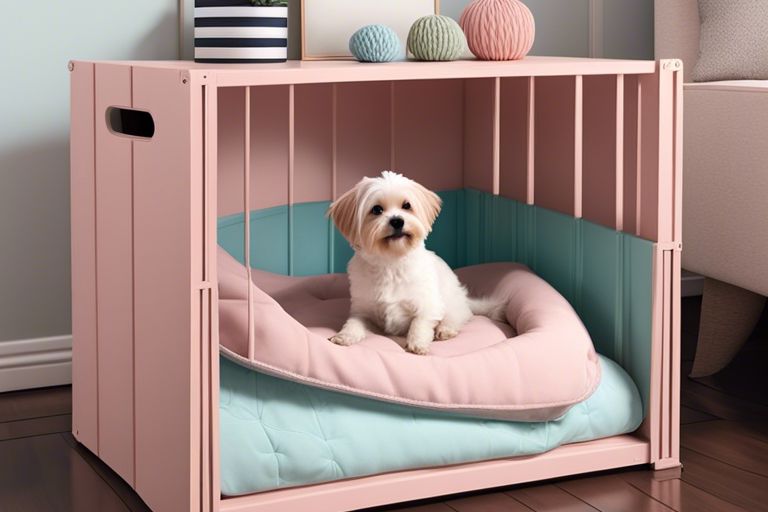Utilizing a crate for your small dog can benefit both you and your furry friend in numerous ways. As a responsible pet owner, it is essential to carefully consider this option and make an informed decision. Contrary to popular belief, using a crate is not cruel or inhumane, but can actually provide a safe and secure environment for your small dog. In this blog post, I will discuss the benefits of using a crate, as well as address common concerns and misconceptions surrounding this controversial topic. Whether you’re considering crate training for potty training, behavioral issues, or simply providing a safe space for your dog, I will provide you with the information you need to make the best decision for your canine companion.
Key Takeaways:
- Crate training can be beneficial for small dogs. Using a crate can help with potty training and preventing destructive behavior when you’re not home.
- Proper crate sizing is crucial. The crate should be just big enough for your small dog to stand up, turn around, and lie down comfortably. Too big of a crate can lead to potty accidents.
- Introduce the crate to your dog gradually and use positive reinforcement. Make the crate a positive place by using treats, toys, and praise. Avoid using the crate as a form of punishment.
The Fundamentals of Crating
Clearly, the decision to crate your small dog is a personal one that should not be taken lightly. There are different opinions on whether or not crating is beneficial for dogs, and it’s essential to weigh the pros and cons before making a decision. For a comprehensive discussion on this topic, I highly recommend reading the article To Crate or Not To Crate? – Karen Pryor Clicker Training.
What is a Crate?
A crate is a small, enclosed area that is typically made of wire, plastic, or fabric. It is used as a safe and secure place for your dog to rest, sleep, or relax. Crates come in various sizes, and it’s essential to choose one that is appropriate for the size of your small dog.
The History and Evolution of Dog Crating
The practice of crating dogs has been around for centuries and has evolved from using simple enclosures made of wood or metal to the more modern, portable crates available today. The primary purpose of crating has shifted from being a tool for confinement to a place of comfort and security for dogs.
Benefits of Crating Small Dogs
The use of a crate for your small dog comes with various benefits, both for you and your furry friend. Crating provides a safe and secure space for your dog, aiding in their training, behavior, and overall well-being.
Safety Considerations
When properly introduced and used, a crate can be a safe haven for your small dog. It can protect them from potential dangers in the home when you are not around to supervise. Additionally, in situations such as travel or visits to the vet, having your dog familiar with their crate can reduce stress and ensure their safety.
Training and Behavior Advantages
Using a crate can aid in housebreaking your small dog, as it teaches them to hold their bladder and bowel movements until they are taken outside. It also helps in preventing destructive behavior, as it gives your dog a designated space to rest and relax. This can also be helpful in teaching your dog to be calm and well-behaved when visitors come to your home.
Health and Comfort Aspects
The use of a crate can provide a sense of security and comfort for your small dog, much like a den in the wild. It gives them a space of their own where they can retreat and feel safe. Additionally, crating can prevent your dog from getting into potentially harmful substances or objects when you are not able to supervise them.

Common Concerns and Misconceptions
Now, let’s address some common concerns and misconceptions about using a crate for your small dog. There are a lot of myths and misunderstandings surrounding crate training, so it’s important to separate fact from fiction.
Potential Psychological Effects
When considering whether to use a crate for your small dog, it’s important to take into account the potential psychological effects. Many people worry that crating their dog can lead to anxiety or stress. However, when used correctly, a crate can actually provide a safe and secure space for your dog, reducing their anxiety and helping them feel more relaxed when you’re not around.
Crate Size and Time Limitations
Another concern that often comes up is the issue of crate size and time limitations. Some people worry that their dog will be confined to a small, cramped space for too long, leading to discomfort or even physical harm. However, it’s important to choose the right size crate for your dog, ensuring that they have enough room to stand up, turn around, and stretch out comfortably. Additionally, it’s crucial to avoid leaving your dog in the crate for extended periods of time, as this can lead to feelings of confinement and distress.
Alternatives to Crating
While crating can be an effective training tool for many small dogs, it’s not the only option available. Some pet owners prefer to use baby gates or playpens to confine their dog to a specific area of the house, rather than using a crate. This can be a good alternative for dogs who find crating distressing, as it still provides boundaries and confinement without the enclosed feeling of a crate. Additionally, some small dogs may be well-behaved enough to be left to roam freely in a pet-proofed area of the home while their owners are away.
By providing the proper information and debunking misconceptions, I aim to help you make an informed decision about whether using a crate is the best option for your small dog. Remember, every dog is different, so it’s important to consider your own dog’s needs and personality when making this decision. Ultimately, the welfare and comfort of your small dog should be the top priority when deciding whether to use a crate.
Best Practices for Crate Training
Your small dog’s crate should be a safe and comfortable space for them to retreat to when they need a break or some alone time. It’s important to establish a positive association with the crate and provide proper training to ensure your dog’s well-being and happiness.
Choosing the Right Crate
When choosing a crate for your small dog, it’s important to consider their size and comfort. The crate should be just big enough for your dog to stand up, turn around, and lie down comfortably. Too much space can lead to your dog using a part of the crate as their bathroom. Additionally, consider the material of the crate – wire crates provide better ventilation and visibility, while plastic crates offer more privacy and security.
Step-by-Step Crate Training Guide
Crate training should be done gradually to help your dog adjust to their new space. Start by introducing the crate and allowing your dog to explore it at their own pace. Place their favorite toys or a comfortable bed inside to make it inviting. Then, start feeding your dog near the crate and eventually inside it to create positive associations. Slowly increase the amount of time your dog spends inside the crate, making sure to praise and reward them for calm, relaxed behavior. Below is a step-by-step guide to crate training:
| Step | Description |
| Introduction to the crate | Allow your dog to explore the crate freely without any pressure. |
| Feeding near the crate | Place your dog’s food bowl near the crate to create a positive association. |
| Feeding inside the crate | Gradually move the food bowl inside the crate to encourage your dog to enter. |
| Increasing time inside the crate | Gradually increase the amount of time your dog spends inside the crate, starting with short intervals. |
Troubleshooting Common Issues
If your dog is having trouble adjusting to their crate, it’s important to address the issue with patience and understanding. Common issues such as whining, barking, or attempting to escape the crate can be resolved with proper training and positive reinforcement. It’s essential to identify the root cause of the problem and address it accordingly. Remember, never use the crate as a form of punishment, as this can lead to negative associations and anxiety.
Should I use a crate for my small dog?
Presently, I firmly believe that using a crate for your small dog can be incredibly beneficial for both you and your furry friend. Not only does it provide a safe and secure space for your dog while you’re away, but it also aids in potty training, prevents destructive behavior, and can be helpful in managing your dog’s anxiety. Additionally, it can be a valuable tool for travel and can provide a sense of security for your dog in unfamiliar environments. Ultimately, using a crate can foster a sense of routine and structure for your small dog, leading to a happier and more well-adjusted pet.
FAQ
Q: Should I use a crate for my small dog?
A: Yes, using a crate for your small dog can be beneficial for several reasons. It provides a safe and secure space for your dog, especially when you are not at home. It can also aid in house training and prevent destructive behavior.
Q: What size crate should I get for my small dog?
A: When choosing a crate for your small dog, it’s important to select the correct size. The crate should be large enough for your dog to stand up, turn around, and lie down comfortably. It should not be too big, as this can defeat the purpose of creating a den-like environment for your dog.
Q: How do I introduce my small dog to a crate?
A: Introducing your small dog to a crate should be done gradually and positively. Start by placing the crate in a common area and leaving the door open. Encourage your dog to explore the crate on their own and consider using treats and praise to create a positive association. Once your dog is comfortable going in and out of the crate, you can start closing the door for short periods of time, gradually increasing the duration as your dog becomes more accustomed to it.


